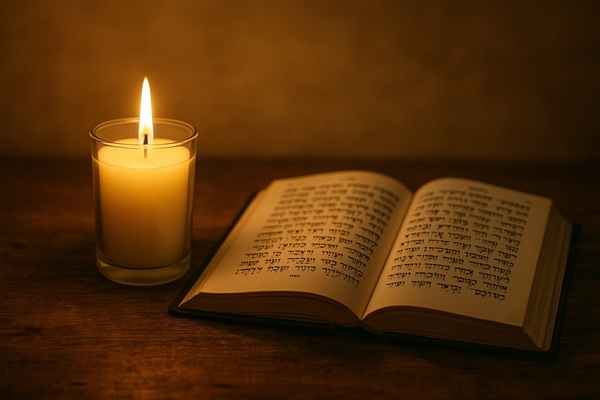Have you ever marked the anniversary of a loved one’s passing and felt unsure of the right way to honor their memory? In Jewish tradition, there’s a deeply meaningful ritual for that—it’s called a yahrzeit (יאָרצײַט). Central to this remembrance is the yahrzeit prayer, a powerful expression of grief, gratitude, and ongoing connection.

What Is a Yahrzeit?
Let’s start with the word itself—yahrzeit (יאָרצײַט) comes from Yiddish, meaning “year time.” In Hebrew, it’s referred to as askarat neshamah (אַזכָּרַת נְשָׁמָה), meaning “remembrance of the soul.” It marks the anniversary of a loved one’s death, observed according to the Hebrew calendar (לוח עברי), not the Gregorian one we use every day.
Traditionally, it’s a sacred moment—a pause each year to reflect, honor, and remember someone who has passed. This practice is deeply rooted in Jewish tradition, serving both as a religious obligation and an emotional anchor for the living. Many find it grounding—an annual moment to say, “You are not forgotten.”
The Significance of the Yahrzeit Prayer
So why a specific prayer? In Judaism, prayer—תפילה (tefillah)—isn’t just about words. It’s about intention (kavanah – כוונה), connection, and remembrance. The primary yahrzeit prayer is the Mourner’s Kaddish (קדיש יתום), which isn’t actually about death. It’s a declaration of the greatness of God’s name—an act of praise during a moment of pain.
Why do we say it? Because many believe it helps elevate the soul of the departed—aliyat neshamah (עליית נשמה)—and connects us with generations past. It also serves as a way to declare that, even in loss, we affirm life and community.
When Is the Yahrzeit Prayer Recited?
The yahrzeit is observed every year on the Hebrew date of death—not the secular one—so it moves around on the Gregorian calendar.
The Mourner’s Kaddish is usually recited:
- At synagogue services (שׁוּל – shul), especially during Shacharit (שחרית – morning prayer), Minchah (מנחה – afternoon), and Ma’ariv (מעריב – evening)
- With a minyan (מניין), a quorum of ten Jewish adults
- Sometimes during the Shabbat closest to the yahrzeit if attending on the exact day isn’t possible
If the death occurred during a leap year (שנה מעוברת), rabbis follow specific rules to determine the appropriate date.
What Is Included in the Yahrzeit Prayer?
The core of the yahrzeit prayer is the Mourner’s Kaddish (קדיש יתום). Though it mentions neither death nor mourning explicitly, its sanctification of God’s name is meant to bring comfort and strength to the bereaved.
Mourner’s Kaddish – קדיש יתום
Hebrew: יִתְגַּדַּל וְיִתְקַדַּשׁ שְׁמֵהּ רַבָּא
בְּעָלְמָא דִּי בְרָא כִרְעוּתֵהּ
וְיַמְלִיךְ מַלְכוּתֵהּ
בְּחַיֵּיכוֹן וּבְיוֹמֵיכוֹן
וּבְחַיֵּי דְכָל בֵּית יִשְׂרָאֵל
בַּעֲגָלָא וּבִזְמַן קָרִיב, וְאִמְרוּ: אָמֵן
יְהֵא שְׁמֵהּ רַבָּא מְבָרַךְ
לְעָלַם וּלְעָלְמֵי עָלְמַיָּא
יִתְבָּרַךְ וְיִשְׁתַּבַּח
וְיִתְפָּאַר וְיִתְרוֹמַם
וְיִתְנַשֵּׂא וְיִתְהַדָּר
וְיִתְעַלֶּה וְיִתְהַלָּל שְׁמֵהּ דְּקוּדְשָׁא בְּרִיךְ הוּא
לְעֵלָּא מִן כָּל בִּרְכָתָא וְשִׁירָתָא
תֻּשְׁבְּחָתָא וְנֶחֱמָתָא
דַּאֲמִירָן בְּעָלְמָא, וְאִמְרוּ: אָמֵן
יְהֵא שְׁלָמָא רַבָּא מִן שְׁמַיָּא
וְחַיִּים עָלֵינוּ וְעַל כָּל יִשְׂרָאֵל, וְאִמְרוּ: אָמֵן
עוֹשֶׂה שָׁלוֹם בִּמְרוֹמָיו
הוּא יַעֲשֶׂה שָׁלוֹם עָלֵינוּ
וְעַל כָּל יִשְׂרָאֵל, וְאִמְרוּ: אָמֵן
Transliteration: Yitgadal v’yitkadash sh’mei rabba
B’alma di v’ra chir’utei
V’yamlich malchutei
B’chayeichon uvyomeichon
Uv’chayei d’chol beit Yisrael
Ba’agala uvizman kariv, v’imru: Amen.
Y’hei sh’mei rabba m’varach
L’alam ul’almei almaya.
Yitbarach v’yishtabach
V’yitpa’ar v’yitromam
V’yitnasei v’yit’hadar
V’yit’aleh v’yit’halal sh’mei d’kudsha b’rich Hu
L’eila min kol birchata v’shirata
Tushb’chata v’nechemata
Da’amiran b’alma, v’imru: Amen.
Y’hei sh’lama rabba min sh’maya
V’chayim aleinu v’al kol Yisrael, v’imru: Amen.
Oseh shalom bimromav
Hu ya’aseh shalom aleinu
V’al kol Yisrael, v’imru: Amen.
English Translation: May His great name be exalted and sanctified
In the world that He created as He willed
May He establish His kingdom
In your lifetime and in your days
And in the lifetime of all the house of Israel
Speedily and soon; and say, Amen.
May His great name be blessed
Forever and ever.
Blessed, praised, glorified, exalted,
Extolled, honored, elevated, and lauded
Be the name of the Holy One, blessed be He
Above and beyond all the blessings and hymns,
Praises and consolations
That are uttered in the world; and say, Amen.
May there be abundant peace from Heaven
And life upon us and upon all Israel; and say, Amen.
He who makes peace in His heights
May He make peace upon us
And upon all Israel; and say, Amen.
How to Observe a Yahrzeit
Reciting the Kaddish is central, but it’s not the only way to mark the day. Many observe yahrzeit with a combination of rituals, personal reflection, and acts of kindness.
🕯️ Light a yahrzeit candle (נר נשמה – ner neshamah) at sunset on the eve of the yahrzeit. It burns for 24 hours, symbolizing the enduring light of the soul.
🕍 Attend synagogue services and say Kaddish with a minyan. Some families sponsor the service or offer a short Torah teaching in the loved one’s memory.
💙 Give tzedakah (צדקה – charity) in the name of the deceased. It’s a meaningful way to create lasting merit on their behalf.
📖 Learn Torah or share stories about the person. Memory lives not just in rituals but in words, values, and love passed down.
What If You Can’t Recite the Yahrzeit Prayer in Person?
Life happens—you might not be able to attend synagogue or find a minyan. That’s okay.
- You can light a candle and reflect at home. Say a psalm, share a memory, or speak their name aloud.
- Some synagogues will say Kaddish on your behalf—just call or email in advance.
- Many communities now offer virtual minyanim, so you can still participate remotely.
Yahrzeit is about intention. Even the simplest act can hold deep meaning when done with a full heart.
